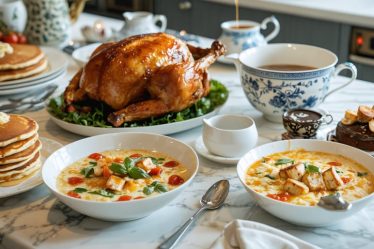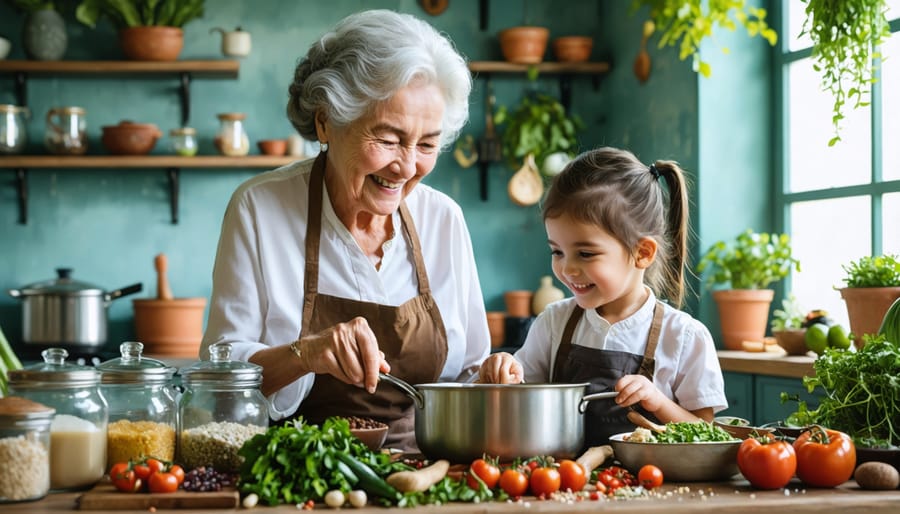
In every steaming pot of grandmother’s soup and every carefully folded dumpling lies a story that spans generations. Food isn’t just sustenance – it’s the thread that weaves together our memories, traditions, and cultural identity. From the aromatic spices of Indian kitchens to the precise knife work of Japanese cuisine, culinary cultures tell the tale of human migration, adaptation, and innovation across centuries.
The way we cook and share meals reflects more than just taste preferences; it embodies our ancestors’ wisdom, survival strategies, and celebrations. Today’s modern families might struggle to maintain these deep-rooted food traditions amid busy schedules and global influences, yet the power of culinary heritage remains undiminished. Whether it’s the comforting aroma of fresh-baked bread in European households or the complex layering of flavors in Middle Eastern dishes, these cooking traditions serve as living museums of human experience.
As our world becomes increasingly connected, understanding and preserving culinary cultures has never been more crucial. These food traditions don’t just preserve our past – they provide a bridge to our future, helping us maintain our cultural identity while adapting to contemporary life. They remind us that every meal is an opportunity to connect with our roots and share our story with the next generation.
The Heart of Culinary Culture: More Than Just Recipes
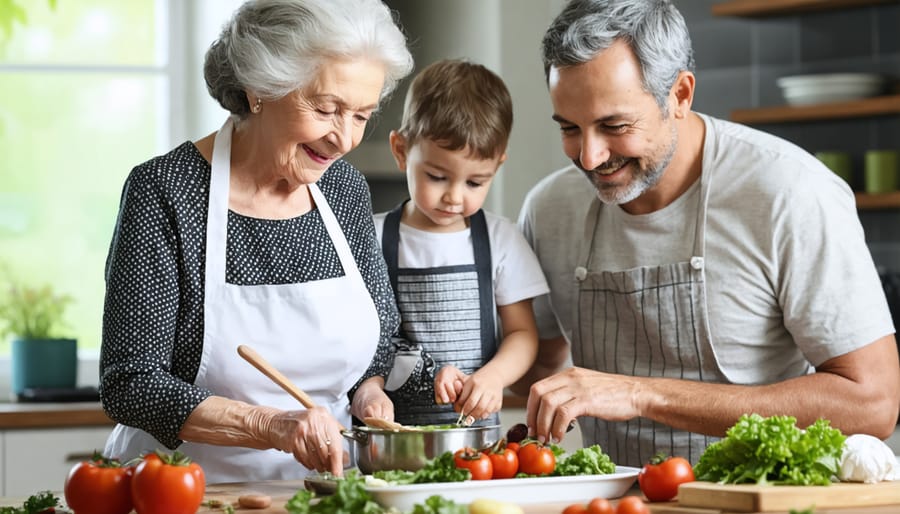
Stories Told Through Spices
Every pinch of turmeric in my grandmother’s curry tells a story of monsoon evenings spent in her kitchen, where the gentle tap of her wedding bangles against steel vessels created a melody that still echoes in my memory. Family recipes are more than just instructions; they’re time capsules preserving generations of love, wisdom, and cultural identity through carefully chosen spices and time-honored techniques.
The way your mother’s hands instinctively know just how much cinnamon to add to the holiday cookies, or how your aunt can tell when the sofrito is perfect just by its aroma – these aren’t just cooking skills, they’re inherited wisdom passed down through generations. Each spice blend holds within it stories of immigration, adaptation, and resilience.
Consider how cardamom pods in Swedish pastries tell tales of ancient trade routes, or how Cajun seasoning speaks of cultural fusion in Louisiana’s history. When we prepare these dishes, we’re not just cooking; we’re keeping alive the narratives of those who came before us.
Today’s modern kitchens might look different from our ancestors’, but when we reach for that special spice mix or follow that carefully preserved recipe card, we become part of an unbroken chain of storytellers, sharing our heritage one dish at a time.
The Language of Love Through Food
In every culture around the world, food serves as a universal language of love, weaving together generations through shared meals and cherished traditions. When a grandmother spends hours perfecting her comforting family recipes, she’s not just cooking – she’s passing down stories, memories, and cultural heritage.
I remember watching my own mother prepare Sunday dinners, her hands working methodically as she shared tales of how her mother taught her these same dishes. These moments in the kitchen aren’t just about feeding our bodies; they’re about nourishing our connections with loved ones. Whether it’s a mother packing a special lunch for her child or a friend bringing over a homemade soup when you’re under the weather, food becomes a tangible expression of care and concern.
In many households, traditional recipes serve as bridges between past and present. The act of preparing these dishes together creates opportunities for meaningful conversations, allowing families to maintain their cultural identity while creating new memories. It’s in these shared moments – chopping vegetables side by side, learning the perfect spice blend, or simply gathering around the dinner table – that we strengthen our bonds and keep our heritage alive.
Modern Kitchens, Timeless Traditions
Preserving Heritage in a Fast-Paced World
In our fast-paced world, preserving culinary heritage might seem like a daunting task, but it’s more achievable than you might think. I’ve discovered that incorporating mindful cooking traditions into our modern routines doesn’t require hours in the kitchen – it’s about making intentional choices with the time we have.
Start by dedicating just one weekend morning a month to learning a traditional recipe from an older family member, whether in person or via video call. These sessions aren’t just about cooking; they’re precious moments of connection and story-sharing. Create a digital recipe journal on your phone, complete with voice notes and photos, making it easy to reference family recipes on busy weekdays.
Technology can be your ally in maintaining family dinner traditions while managing a hectic schedule. Use meal prep sessions to batch-cook traditional dishes, freezing portions for future meals. Involve children in simple prep tasks, teaching them about their culinary heritage while making memories together.
Consider starting a neighborhood cooking club where families take turns sharing their cultural recipes. This not only helps preserve various traditions but also builds community connections. Remember, even small efforts – like using traditional spices in quick weeknight meals or telling stories about family recipes during dinner – help keep your culinary heritage alive.
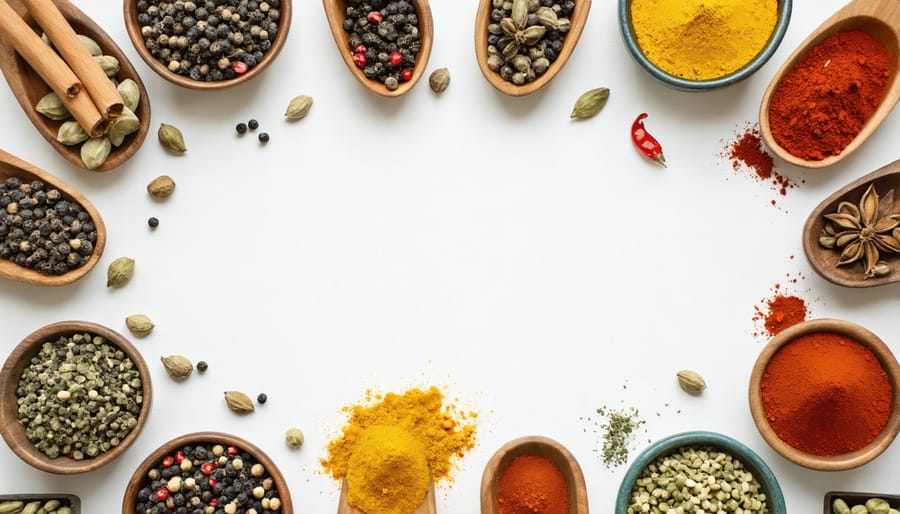
Fusion Cooking: When Cultures Blend
In my kitchen, where traditional recipes from my grandmother mingle with modern ingredients, I’ve discovered the joy of fusion cooking. It’s a delicate dance between honoring our heritage and embracing the present, something many families navigate daily. Like adding quinoa to traditional stuffed grape leaves or incorporating sriracha into classic meatballs, these adaptations reflect our evolving cultural identity.
The key to successful fusion cooking lies in understanding the essence of traditional dishes. When my mother-in-law taught me her secret dumpling recipe, she explained that while ingredients might change, the technique and love poured into each fold remain constant. Today’s busy families are creating beautiful hybrid dishes that tell their unique stories – Korean-Mexican tacos, Italian-Indian pasta, or Japanese-Mediterranean bowls.
What makes these adaptations special is how they bring families together, creating new memories while preserving old ones. In my cooking workshops, I’ve seen mothers and daughters work side by side, updating family recipes for modern dietary needs without losing their soul. Sometimes it’s as simple as swapping heavy cream for coconut milk or using gluten-free alternatives in traditional pastries.
Remember, there’s no right or wrong way to adapt family recipes. The most important ingredient is keeping the spirit of the dish alive while making it work for your family’s lifestyle and preferences.
Creating Your Own Culinary Legacy
Documenting Family Recipes
Preserving family recipes is about more than just jotting down ingredients and steps – it’s about capturing the heart and soul of your family’s culinary heritage. Start by sitting down with older family members and recording their cooking stories. Ask about special occasions when they prepared certain dishes, or how recipes evolved over generations.
Create a digital archive using photos of handwritten recipe cards, complete with food stains and margin notes that tell their own stories. Document the little details that make each recipe special – like how Grandma always used her cast iron skillet for cornbread, or how Mom’s secret ingredient was actually love (and a pinch more cinnamon than the recipe called for).
Consider starting a family cookbook project. Include notes about ingredient substitutions, common mistakes to avoid, and family memories associated with each dish. Take photos of the finished dishes, and even better, capture pictures of family members cooking together.
Don’t forget to record the sensory details – the way the kitchen smells when the dish is cooking, the sound of butter sizzling in the pan, or how you know the dough feels right. These details help preserve not just the recipe, but the entire experience for future generations.
Starting New Food Traditions
In today’s fast-paced world, establishing new food traditions doesn’t mean abandoning the old ones – it’s about adapting and creating meaningful meal experiences that fit our modern lives. Start by designating one evening a week for a special family dinner, where everyone participates in meal preparation. This could be “World Food Wednesday,” where you explore a different cuisine each week, or “Sunday Soup Club,” where friends gather to share homemade soups and stories.
Technology can actually enhance our food traditions rather than diminish them. Set up monthly virtual cooking sessions with far-away relatives, where grandma can teach her secret recipes to the grandkids via video chat. Document your family’s food journey through a shared digital recipe collection or Instagram account dedicated to your culinary adventures.
Consider starting a neighborhood food swap or seasonal potluck series. These gatherings not only build community but also introduce your family to diverse cooking styles and ingredients. Remember, the most lasting traditions often start small – maybe it’s making pancakes together every Saturday morning or having a monthly “kitchen experiment” day where kids can safely explore their culinary creativity.
The Social Power of Shared Meals
Beyond the Family Table
Food traditions have a remarkable way of extending beyond our kitchen walls to weave communities together. I’ve witnessed this firsthand at our neighborhood’s annual multicultural food festival, where sharing recipes becomes a bridge between different cultures and generations.
These community connections often start small – perhaps with a borrowed cup of sugar from a neighbor or sharing your grandmother’s secret pasta sauce with a friend. Before you know it, these simple acts of culinary kindness blossom into lasting bonds. In my community, what began as casual recipe swaps during school bake sales has evolved into monthly potluck dinners where families share their heritage through food.
The impact of shared culinary traditions reaches far beyond mere sustenance. Local farmers’ markets become gathering spots where food stories are exchanged alongside fresh produce. Community gardens cultivate both vegetables and friendships, while cooking classes at community centers help preserve traditional techniques while fostering new relationships.
Social media has added another dimension to these connections, with Facebook groups dedicated to regional cooking and Instagram accounts celebrating specific cultural cuisines. These digital platforms help preserve and share food traditions while creating virtual communities that span continents.
Whether it’s organizing a block party featuring dishes from every household, volunteering at a community kitchen, or simply sharing a meal with neighbors, food continues to be one of our most powerful tools for building meaningful connections. These shared culinary experiences remind us that despite our differences, we all speak the universal language of food.
Celebrating Diversity Through Food
Food has an incredible way of bringing people together, transcending language barriers and cultural differences. I remember hosting a neighborhood potluck where Sarah, my Vietnamese neighbor, brought her family’s traditional pho recipe, while Maria shared her grandmother’s authentic Mexican tamales. The evening turned into a beautiful exchange of stories, cooking techniques, and cherished memories.
When we share meals from our heritage, we’re not just sharing food – we’re offering a piece of our identity, history, and family traditions. Each dish carries stories of generations past, migration journeys, and cultural celebrations. Whether it’s learning how to properly eat with chopsticks or understanding why certain spices are sacred in various cuisines, these interactions foster genuine appreciation for different cultures.
Food festivals and cultural celebrations have become increasingly popular ways to celebrate diversity in our communities. These events create safe spaces where people can proudly showcase their traditional dishes while learning about others’. It’s heartwarming to see children especially embrace these opportunities, asking questions about unfamiliar ingredients and eagerly trying new flavors.
The kitchen can be our first classroom for cultural understanding. By cooking and sharing meals from different traditions, we learn patience, respect, and appreciation for the unique ways people around the world nourish themselves and their communities. Whether you’re swapping recipes with colleagues or participating in international cooking classes, each culinary exchange builds bridges and deepens our understanding of one another.
Remember, celebrating diversity through food isn’t about perfect authenticity – it’s about opening our hearts and minds to new experiences while honoring the stories and traditions behind each dish.
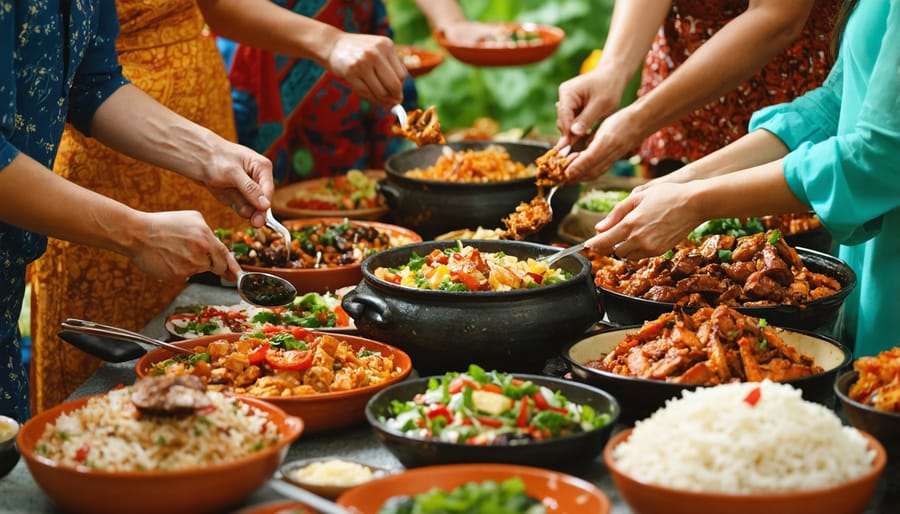
As we reflect on the rich tapestry of culinary cultures that enrich our world, it becomes clear that our food heritage is so much more than just recipes passed down through generations. It’s the stories behind our grandmother’s secret sauce, the laughter shared around family dinners, and the pride that swells when teaching our children how to knead dough just the way our parents taught us.
In today’s fast-paced world, preserving these culinary traditions might seem challenging, but it’s more important than ever. Each time we recreate a traditional dish or share a family recipe, we’re not just preparing food – we’re keeping our cultural identity alive and creating lasting memories for future generations.
I encourage you to embrace your own food heritage, whether it’s through documenting family recipes, hosting cultural cooking sessions with friends, or simply taking the time to learn the stories behind your favorite traditional dishes. Don’t be afraid to adapt these traditions to fit your modern lifestyle while maintaining their core essence.
Remember, every meal you prepare with cultural significance is an act of preservation and celebration. By sharing these traditions with others, we create bridges between communities and foster understanding through the universal language of food. Let’s commit to keeping our culinary heritage vibrant and alive, one dish at a time.

